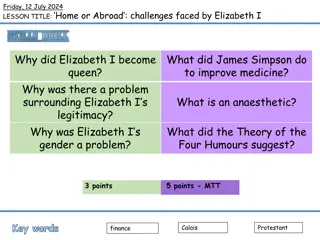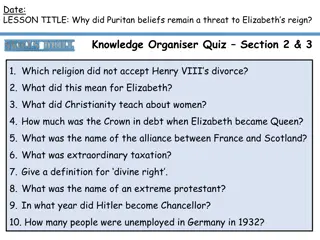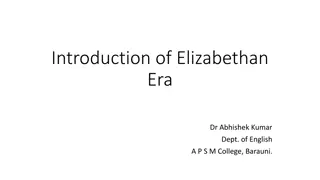
Exploring the Historic Environment of Elizabethan England Through Hardwick Hall Study
Delve into the historic environment of Elizabethan England through a detailed study of Hardwick Hall, focusing on its significance, key features, and connection to broader historical events and developments. Understand the relationship between the site and the period studied, exploring themes of change, continuity, causation, and consequence. Discover the cultural, social, and architectural aspects that shaped people's lives during that era.
Download Presentation

Please find below an Image/Link to download the presentation.
The content on the website is provided AS IS for your information and personal use only. It may not be sold, licensed, or shared on other websites without obtaining consent from the author. If you encounter any issues during the download, it is possible that the publisher has removed the file from their server.
You are allowed to download the files provided on this website for personal or commercial use, subject to the condition that they are used lawfully. All files are the property of their respective owners.
The content on the website is provided AS IS for your information and personal use only. It may not be sold, licensed, or shared on other websites without obtaining consent from the author.
E N D
Presentation Transcript
01 Study Interpretation A in the Interpretations Booklet. How convincing is Interpretation A about ..? Explain your answer using Interpretation A and your contextual knowledge. [8 marks]
02 Explain what was important about the . [8 marks]
03 Write an account of the ways in which. [8 marks]
04 The main . How far does a study of Hardwick Hall support this statement? Explain your answer. You should refer to Hardwick Hall and your contextual knowledge. [16 marks]
Part four: The historic environment of Elizabethan Part four: The historic environment of Elizabethan England ( England (Hardwick Hall (2018) ) The historic environment is 10% of the overall course, which equates to approximately 12 hours out of 120 guided learning hours. Students will be examined on a specific site in depth. This site will be as specified and will be changed annually. The site will relate to the content of the rest of this depth study. It is intended that study of different historic environments will enrich students understanding of Elizabethan England. There is no requirement to visit the specified site. Teachers may wish to visit a similar site in their locality to inform their teaching, however no reward will be given in the assessment for visiting the specified site or any other site. The study of the historic environment will focus on a particular site in its historical context and should examine the relationship between a specific place and associated historical events and developments. Students will be expected to answer a question that draws on second order concepts of change, continuity, causation and/or consequence, and to explore them in the context of the specified site and wider events and developments of the period studied. Students should be able to identify key features of the specified site and understand their connection to the wider historical context of the specific historical period. Sites will also illuminate how people lived at the time, how they were governed and their beliefs and values. The following aspects of the site should be considered: location function the structure people connected with the site eg the designer, originator and occupants design how the design reflects the culture, values, fashions of the people at the time how important events/developments from the depth study are connected to the site. Students will be expected to understand the ways in which key features and other aspects of the site are representative of the period studied. In order to do this, students will also need to be aware of how the key features and other aspects of the site have changed from earlier periods. Students will also be expected to understand how key features and other aspects may have changed or stayed the same during the period. The numbers in the brackets below further relate to other parts of the depth study for which the historic environment is relevant. The historic environment can be explored through the examination of Elizabethan buildings such as Tudor manor houses and their gardens (Part two), theatres (Part two) and wider historic environments such as villages, towns and cities (Part two). Equally key historic developments and events such as voyages and trade (Part two), revolts (Parts one and three), and battles (Part three) were shaped by the historic environment in which they took place. For all series the specified site will be published three years in advance at aqa.org.uk/history Optional resource packs will accompany each site, which teachers may wish to use to form part of their teaching of the course. Other sources of information about the specified sites may also be considered.






















